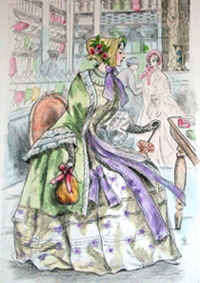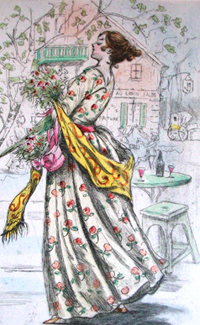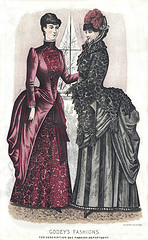 Interested in taking a look at the historical fashions for women? If yes, then check out some of the beautiful rare materials available at the Sheridan Libraries in our different locations. We have a good collection of fashion plates at the Department of Rare Books and Manuscripts. Fashion plates are beautifully done illustrations that show the popular fashions of different historical eras. Not only are these illustrations fun to browse, but they are also valuable resources useful for research. What can we learn from these fashion plates?
Interested in taking a look at the historical fashions for women? If yes, then check out some of the beautiful rare materials available at the Sheridan Libraries in our different locations. We have a good collection of fashion plates at the Department of Rare Books and Manuscripts. Fashion plates are beautifully done illustrations that show the popular fashions of different historical eras. Not only are these illustrations fun to browse, but they are also valuable resources useful for research. What can we learn from these fashion plates?
The study of clothing styles is important in understanding the socio-economic status of people. Clothes signify the social status and class of a man or a woman. They have been used to shape gender and class identities. Differences in dress materials, styles, and additional clothing accessories such as, hats, gloves, hand fans, etc. convey to us the disparities that existed. Hence, they are useful in comprehending the variations between the different social classes of the bygone historical eras.
 Moreover, clothes reveal the popular fashions of various historical periods and also serve as a means to express people’s identity. Likewise, the differences between the male and female attires illustrate the perceptions of the gender roles and historical notions of masculinity and femininity. In the earlier historical eras, only the affluent were able to afford new garments. The poor merely wore used clothes. This was not surprising as clothes were hand-made and only the affluent were able to afford beautiful and expensive dresses. In the eighteenth century, with new inventions and technological developments in textile machinery, it became easier to produce clothes that were affordable.
Moreover, clothes reveal the popular fashions of various historical periods and also serve as a means to express people’s identity. Likewise, the differences between the male and female attires illustrate the perceptions of the gender roles and historical notions of masculinity and femininity. In the earlier historical eras, only the affluent were able to afford new garments. The poor merely wore used clothes. This was not surprising as clothes were hand-made and only the affluent were able to afford beautiful and expensive dresses. In the eighteenth century, with new inventions and technological developments in textile machinery, it became easier to produce clothes that were affordable.
 Apart from books, we also have historical newspapers which feature articles on popular historical fashions and you may even find illustrations in some issues. You can search the Illustrated London News, the Times Digital Archive, the Early American Newspapers, the New York Times and other newspapers listed on our News and Newspaper guide for more information. These newspapers published several articles describing the fashion trends for different seasons.
Apart from books, we also have historical newspapers which feature articles on popular historical fashions and you may even find illustrations in some issues. You can search the Illustrated London News, the Times Digital Archive, the Early American Newspapers, the New York Times and other newspapers listed on our News and Newspaper guide for more information. These newspapers published several articles describing the fashion trends for different seasons.
If your interest has been piqued, then I recommend that you check out some of the fashion periodicals that we have in our collection. Some of these periodicals such as Harper’s Bazaar, Peterson’s Magazine, Godey’s Lady’s Book, Vanity Fair, and Glamour are available online. To see the historical fashion plates in person, check out the George Peabody Library for Harper’s Bazaar, The Delineator, M’me Demorest’s Quarterly Mirror of Fashions, The Monthly Journal of Fashion and Journal des Demoiselles. You can also search the holdings of the Peabody Library and the Garrett Library for other rare items on costumes and fashions. For a sample, enjoy a slideshow of some of the fashion plates from the book, Les modes féminines du XIXe siècle interprétées en cent pointes sèches aquarellées au pinceau, 1801-1900, by Henri Boutet available at the Geroge Peabody Library. To learn more about the available research resources on this subject, consult the fashion history page on the history guide.

We have come a long way 🙂